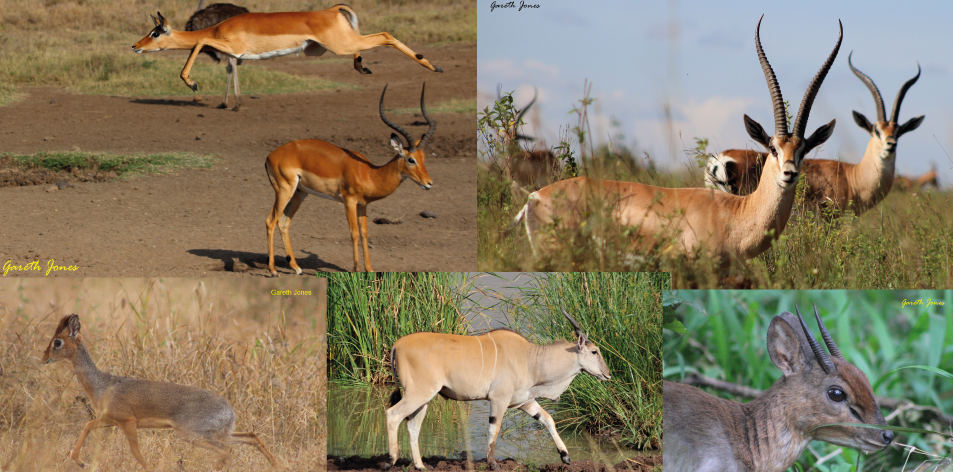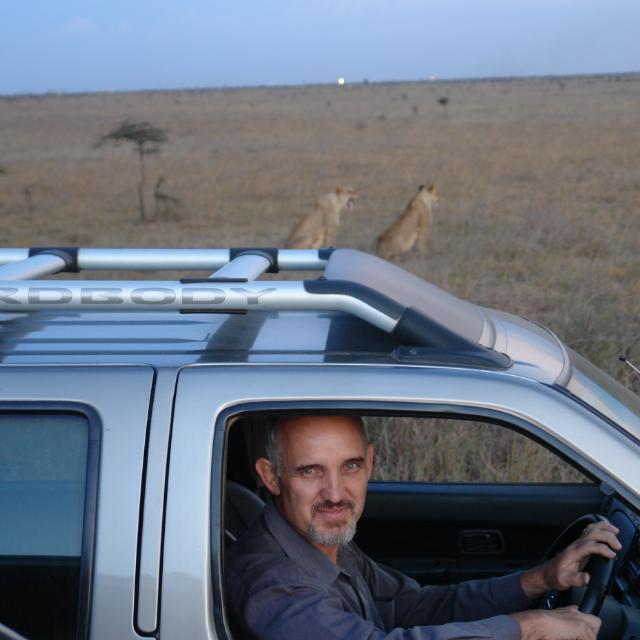
The Unique African Antelope – Article by Gareth Jones
UNIQUE AFRICAN ANTELOPE – BY GARETH JONES
Wow! What a sight for the naked eye to behold, before me stood a big herd of elands, moving slowly across the Embakasi plains as they grazed and interacted with each other. So many young calves appeared to be cavorting and running after each other, and then finding refuge with their mothers. But what impressed me most was the magnificently massive large bulls, their huge bulk stood out from the herd, and it was then easy to see why the eland is Africa’s largest antelope.
Nairobi park is amazing in this way, for having the largest antelope; the eland, to one of the smallest; the suni. Elands are found in many places in Africa, and have become scarce in some areas, so the Nairobi Park is a place of refuge for them to breed and live in relative safety. It is interesting to note that in all the years I have been observing in the park, there have been very few eland lion kills, it appears they are very fleet footed and also intelligent. Elands have also been known to jump very high easily clearing fences. They are not generally harmful and have a placid nature, that has even resulted in them becoming quite tame in some areas.
While driving on the tar road towards the main gate in the late afternoon, I saw a tiny antelope eating next to the road. It was a tiny suni, only found in the forested section, and can be seen if driving very slowly, when they feed on green shoots and leaves. They are very shy and sensitive and it is rare to get close to them.
The suni suddenly ran across the road and went into a thick clump of bushes, I was just about to drive onward, when suddenly the suni emerged from the bushes. I could scarcely believe my eyes, a tiny minute little new born lamb was trying to stand and suckle on its mother. WOW! what a super suni sighting, a mega tick on my all time sightings in the park. The lamb could not have been more than an hour or two old, and the mother was trying to force it to walk, as she slowly moved away every time the lamb tried to stand and walk on its wobbly newborn legs. There is always something very precious and special about witnessing the start of a new life.
Suni are often mistaken for dik-dik, the tiny antelope seen in the forest area are almost always Suni (Neotragus moschatu) also know as “Paa’ in Kiswahili, even smaller than dik-dik, they are the smallest antelope in the park. They vary in colour from fawn grey to chestnut brown on the back with white underneath. Dik-dik can be seen on the Western boundary just outside the Masai gate in the Silole Sanctuary and near the Cheetah gate. Next time you drive through the forest be on the lookout for the special suni antelope .
Recently while driving in the Athi basin on the road from the Hippo pools to junction No. 11, we rounded a corner and suddenly a tiny creature jumped into the road. It stood still and looked directly at our vehicle, WOW it was a Kirk’s dik-dik!! Rarely seen in the Nairobi National Park .
Over many years I have personally seen a Kirk’s dik-dik actually inside the park on three occasions, along the Eastern and Southern boundaries, I have also seen them just outside the Masai gate in the Silole Sanctuary. It should be noted that Kenya has three types of dik-dik, namely Kirk’s (in the south) and Günther’s (in the north) and rarely seen Salt’s dik-dik in North Eastern Kenya, in Somalia there are two other dik-dik species namely Salt and Silver, making a total of 4 species of small antelopes in the genus Madoqua (dik-dik) in East Africa. All dik-diks have an elongated nose with a tuft of fur on the top of the head.
They stand about 30–40 centimetres at the shoulder, are 50–70 cm long, weigh 3–6 kilograms and can live for up to 10 years. Dik-diks are named after the alarm calls of the females. Both the male and female make a shrill, whistling sound. These calls may alert other animals to predators.
Some people mistake suni for dik-dik, however suni are only found in the Langata forested section. Suni are even smaller than dik-diks, and vary in colour from fawn grey to chestnut brown on the back with white underneath.
Next time you drive through the park along the rocky dry Eastern Southern boundary be on the lookout for the rarely seen Kirk’s dik-dik.
One fine late afternoon I decided to drive down to the Athi Basin, as I drove it was very evident that some parts of the park were looking green, while other parts towards the Athi Basin was looking very dry, and in need of rain. As I turned a corner in an area with rocky outcrops, an entire family group of 7 mountain reedbuck were positioned near the road. Fascinated with the opportunity to watch them closely, I parked the vehicle. Their behavior is markedly different from other antelope species. There is always a constant watch, while the others feed, and then if there is possible danger, they suddenly all freeze, and stand motionless like statues for some time, from a distance their fawn colour helps them to blend into the surroundings. The females do not have horns, while the male has short sharp forward curving horns.
There are 3 recognized species of reedbuck in Africa, namely Southern, Bohor and Mountain reedbuck. The Bohor reedbuck and the Mountain reedbuck are found in the Nairobi National Park, while the other reedbuck species are heavily dependant on marshy water areas, the mountain reedbuck can live with less water. They are rarely seen by most visitors, as they live in only a few selected rocky locations. It is estimated that there are possibly only about 20 mountain reedbucks in the park.
The green grass of the plains look magnificent after good rains, as a result many herbivores are now having a season of plenty. There are parts of the park where mixed herds of Grant’s & Thomson’s gazelles move around together. I find it interesting that for thousands of years these two types of gazelles have lived in close proximity and yet it seems that they have never interbred. It should be noted that Grant’s gazelle is much larger than the Thomson’s gazelles (also known as tommies). Grant’s gazelles also have light side markings while the tommies have a more defined black side stripe.
Both species are still found in reasonable numbers inside the park, however throughout the parts of Africa and Asia where gazelles are found their numbers have dropped dramatically in recent years . Thomson’s gazelles are from the genera Eudorcas known as E. thomsonii, while the Grant’s gazelle is from the genera Nanger and are known as N. granti. Interestingly both Nanger & Eudorcas generas are scientifically classified as antelope, however they are still called gazelles due to their physical similarities.
Gazelles are very adaptive in dry areas and can often survive in areas where there appears to be no water by means of gaining moisture from the plants they eat. Their enemies are predators such as the cheetahs, leopards, lions, jackals and hyenas and also the super–predator MAN!! Gazelles used to be a common species in many places, but their numbers continue to drop due to complex factors mostly involving mankind. However the Nairobi National Park continues to be a place of refuge for them.
One fine afternoon I drove in the area of the Kingfisher picnic site, looking over the valley below at the splendor before me. The park was looking like a beautiful garden after the good rains with lush green grasses & many wild flowers, but many of the plains species had already moved south onto the Kitengela plains, and even further on their annual migration. It is a small miracle that somehow it still happens every year even with the huge obstacles outside the protected area .
Then suddenly right next to the road I saw a fine herd of Impala, their rusty red colours shone in the afternoon sun. A dominant male chased a few possible contenders away, while other males stood guarding the rest of the herd, as tiny ‘bambi like’ lambs suckled on their mothers. A truly wonderful scene to absorb, as just a few hundred metres away two large male lions sat watching ‘their’ kingdom. An interesting note is that impalas are found over a large area over Southern and Eastern Africa. The early dutch settlers gave the name rooibok (red buck) due to their deep rusty red appearance. Even the city of Kampala is named after the impala from the phrase in luganda “ka-mpala” meaning (place of the Impala). They are commonly preyed upon by leopards, cheetahs and at times lions.
Yes! There is much created diversity to see in the tiny but very unique Nairobi national park including other species such as Coke’s hartebeest (kongoni), bohor reedbuck, grey duiker, steenbok, waterbuck and oribi. I always leave satisfied with “soul tonic”, but remember “the slower the drive, the more you see what’s alive!”
The park is open daily from 06h00 to 19h00.
Gallery
 Gareth Jones – Nairobi Park Dairy – A passionate writer & photographer
Gareth Jones – Nairobi Park Dairy – A passionate writer & photographer
